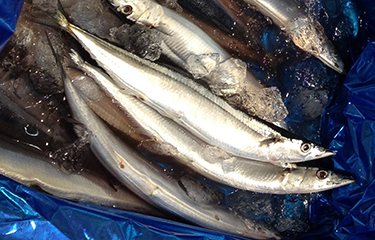The Tokyo-based National Pacific Saury Stick Net Fishery Cooperative announced on 10 January that only 17,910 metric tons (MT) of saury were landed by Japanese vessels in 2022, marking the fourth consecutive year of record lows since statistics started being kept in 1961.
The amount is a two-percent decline from the 18,291 MT caught in 2021, which was down 38 percent from the 29,566 MT caught in 2020, which in turn was down 27 percent from the 40,517 MT landed in 2019. The decline is especially apparent when the current trickle of fish is compared with the nearly 350,000 MT landed in 2008, and the approximately 225,000 MT caught in 2012.
Fishing for the species takes place along the Pacific coast of Hokkaido and the Sanriku area (Aomori, Iwate, and Miyagi Prefectures) in northeast Honshu Island. Traditionally, Sanriku takes most of the catch, but last year the pattern switched and Hokkaido saw moderate increases while Sanriku saw a decline of 65 percent. This year, the amount landed in Honshu was up by 12 percent, while that in Hokkaido was off by 9 percent. However, Hokkaido still got most of the catch with 10,819 MT versus 7,092 MT for Honshu, reflecting the recent more northerly distribution of the schools.
Many interacting factors may be responsible for the decline in catch, including rising surface water temperatures, changes in the interactions of ocean currents in the area, and northward migration of warm-water fish like sardines.
Overfishing by foreign vessels on the high seas is a common complaint among the Japanese, and it is true that warmer water temperatures are keeping the schools in international waters to the northeast of Japan’s exclusive economic zone (EEZ) longer, where they are targeted by factory ships from Taiwan and China.
The North Pacific Fishery Commission (NPFC) annually agrees on quotas for saury, but as the first agreement was set in 2019, it was set much higher than the actual recent catches. The priority at the time was to reach agreement on a quota, which China had long resisted, rather than on making it a strict quota.
However, saury are quite fecund, and can rebound quickly when conditions for recruitment are favorable and plankton is abundant. The science seems to support the idea that regime shifts in currents alternate between an environment of stronger cold-water currents that favors saury, and one of weaker cold-water currents that favors sardines. Sardine catches in Japan have increased concurrent with the decline of saury.
A scientific report from August of 2022, “Effects of oceanographic environment on the distribution and migration of Pacific saury (Cololabis saira) during main fishing season” found that among several environmental measures, surface sea temperature was the strongest predictor of monthly catch. The study examined catch of Pacific saury in Japan and by Chinese fishing vessels fishing in international waters at the edge of Japan’s EEZ during the optimal fishing period of September to November in 2014 through 2017, finding saury were mainly caught in waters at 15 degrees Celsius. As water temperatures cool in the fall, the fish move south.
The report also found that ocean currents play a part. In the Pacific Ocean near Hokkaido, the cold Oyashio Current from the north converges with the warm Kuroshio Current, which flows from the south. After meeting, both currents flow east. An intrusion of the nutrient-rich Oyashio is when a portion of it continues south hugging the coast. The study found that “…the increase in the intrusion area of the Oyashio usually pushed the migration of Pacific saury to the Japanese coastal region. In contrast, when the intrusion area of the Oyashio was reduced, more fish migrated to the high-sea fishing ground.”
An additional factor leading to last year’s poor catch was a reluctance of Japanese fishermen to take their vessels across Russian territorial waters in order to take advantage of reciprocal access agreements that allow Japanese and Russian vessels to fish in each other’s EEZs. Relations between the countries have been strained over Japanese sanctions on Russia following the invasion of Ukraine, and fishermen feared their vessels might be seized.
Regardless of the reasons …
Photo by Chris Loew/SeafoodSource








